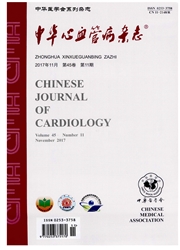

 中文摘要:
中文摘要:
目的 研究扩张型心肌病(DCM)和左心室心肌致密化不全(LVNC)的临床和磁共振成像(MRI)特征,探讨MRI对二者鉴别诊断的价值.方法 分析21例经心脏移植证实为DCM患者、25例临床证实为INNC患者的一般临床资料.利用心脏MRI检查,分析两组患者的左心房、室径线及左心功能,将左心室划分为17节段,对左心室致密化不全的节段进行计数,测量左心室各节段非致密化心肌和致密化心肌的厚度,计算非致密化心肌/致密化心肌比值(NC/C比值).结果 DCM患者全部都有胸闷、气短,心电图异常表现.而25例LVNC患者中21例(84%)患者有胸闷、气短、胸痛等症状,4例(16%)无明确症状.22例(88%)LVNC患者存在心电图异常,3例(12%)心电图无异常发现.心脏MRI显示DCM患者左心房、室扩张更明显,更趋向球形化[DCM球形指数(SI)=0.81±0.06,LVNC SI=0.74±0.11].DCM患者左心室射血分数[LVEF,(15.0±5.1)%]较LVNC[(32.7±14.2)%]低.DCM左心室有过度小梁化倾向,但LVNC患者受累节段即致密化不全的节段数(9±1)比DCM受累节段即过度小梁化节段(5±2)多.所有LVNC患者的心尖段(第17节段)均受累,而DCM患者心尖段未见受累.其他易受累节段在两组患者中分布大致相似,即侧壁中段、心尖段(第16、12、11节段)是最常见的受累节段,而室间隔基底段、中段(第2、3、8、9节段)均未见受累.LVNC患者最常发生致密化不全的心肌节段其致密化心肌厚度变薄,与DCM患者对应节段室壁厚度无差别.而不发生或很少发生致密化不全的节段,LVNC患者致密化心肌厚度比DCM患者对应节段厚.LVNC患者致密化不全心肌厚度与致密化心肌厚度比值(NC/C:3.3±0.6)较DCM患者(1.9±0.3)高,差异有统计学意义.结论 DCM与LVNC患者临床表现有些类似,心脏MRI能够显示二者在左心形态及功能方面的差别,NC的分布及程度对二者的鉴别有很大价值.
 英文摘要:
英文摘要:
Objective To characterize the clinical and cardiac MRI features of dilated cardiomypathy ( DCM) and left ventricular noncompaction (LVNC). Methods Compared the clinical and MRI features between 25 patients with LVNC and 21 patients with DCM. The MRI derived diastolic left ventricular wall thickness and the number and degree of noncompaction (NC) were evaluated using the 17-segment model. Results Chest distress, shortness of breath and abnormal ECG were presented in all DCM patients, abnormal ECG was evidenced in 22 LVNC patients and 21 out of 25 LVNC patients presented similar clinical symptoms as DCM patients while the rest 4 LVNC patients were asymptomatic. Left atrial and ventricular dimensions were significantly smaller in LVNC patients compared to DCM patients. The degree of left ventricular (LV) spherical remodeling was significantly greater in patients with DCM (sphericity index, SI = 0. 81 ± 0. 06) than in patients with LVNC ( SI = 0. 74 ± 0. 11, P 〈 0. 05). The LV ejection fraction ( LVEF) was significantly higher in patients with LVNC (32. 7% ± 14. 2% ) than that in patients with DCM (15. 0% ±5. 1% ). The number of NC segments in LVNC patients (9 ± 1) was significantly higher than the number of hypertrabeculation segment in DCM patients (5 ±2). The left ventricular apex (the 17th segment) was unexceptionally involved in all LVNC patients, while hypertrabeculation was absent in the 17th segment of DCM patients. The NC was more common in the apical and mid segments (16th, 12th and 11th segments) than in basal and mid septal segments (2nd, 3rd, 8th and 9th segments) in both LVNC and DCM patients. The thickness of compacted myocardium of the segments associated with noncompaction appeared thin in two groups. The wall thickness of noncompaction myocardium segments was thicker in LVNC patients than in DCM patients. The end-diastolic NC/C ratio was, on average, higher in patients with LVNC (3. 3 ± 0. 6) than in patients with DCM (1.9 ± 0.
 同期刊论文项目
同期刊论文项目
 同项目期刊论文
同项目期刊论文
 期刊信息
期刊信息
